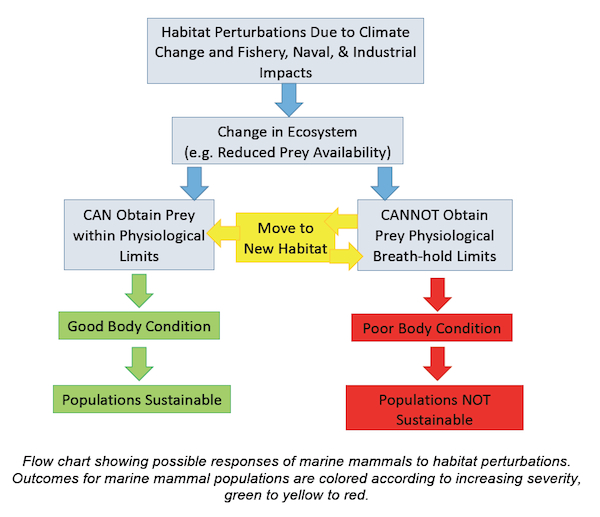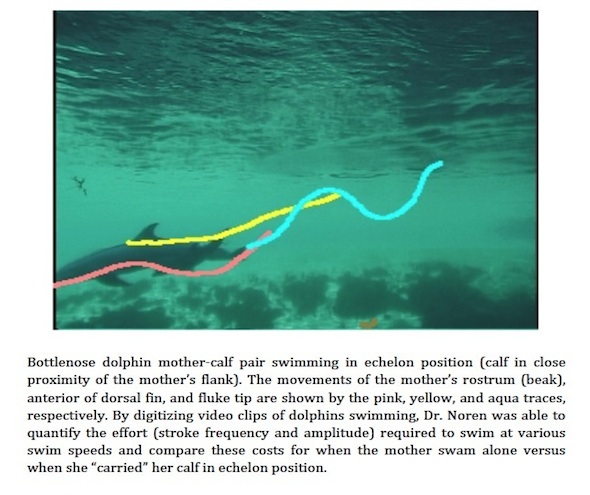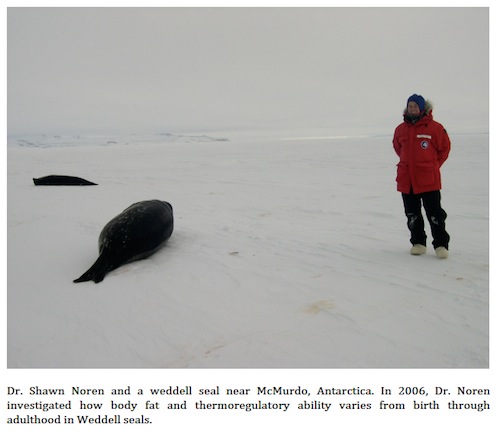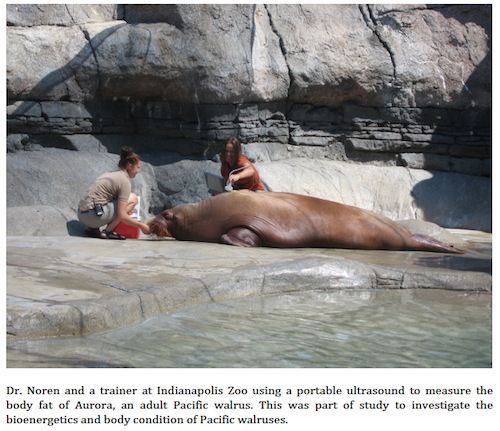Dr. Shawn Noren was fascinated about life in the ocean at an early age, despite her family’s meager earnings precluding her from taking a trip to the ocean until she was 8 years old. Her interest in the ocean was peaked by reading Ranger Rick Magazine, which in the 1970’s highlighted issues facing the survival of marine mammals such as boat strike for manatees in Florida, tuna-purse seine fishery interactions for dolphins in the Eastern Tropical Pacific, and hunting of harp seals in Canada. She knew at that time that she wanted to become a marine biologist so that she could help solve these issues. Fast forward nearly two decades, and she found herself as a graduate student in Dr. Terrie Williams' laboratory at the University of California, Santa Cruz where she learned how to address these issues using physiology as a tool. During her graduate work, she pioneered research on immature marine mammals (particularly cetaceans) because there was a paucity of information on these age-classes, yet these groups are the most vulnerable to habitat perturbations.

After completing her graduate work in 2002, Dr. Noren held several prestigious postdoctoral positions at the Smithsonian Institute in Washington D.C., Southwest Fisheries Science Center-NMFS-NOAA in La Jolla, CA and McMurdo Station, Antarctica. While working in new field settings and with different types of marine mammals (e.g. dolphins, gray seals, Weddell seals), she expanded the types of tools that she uses to quantifying the physiological constraints of marine mammals. Dr. Noren uses numerous laboratory and field techniques, including muscle and blood biochemical analyses, heart rate analyses, body composition analyses via doubly labeled water, oxygen consumption analyses via open-flow respirometery, and movement patterns via radio telemetry and motion analyses software. From these data, she models swimming performance, thermoregulatory abilities, diving capacity, fasting capabilities and bioenergetics.

In 2012, Dr. Noren returned to UCSC as an Associate Research Scientist within the Institute of Marine Sciences. Her research has predominately included collaborations with government agencies such as National Marine Fisheries Service, United States Geological Service, and the United States Navy. She has been exploring the impacts of a fishery interaction on dolphins, global climate change on Arctic marine mammals, and naval disturbance on the body condition of deep-diving odontocetes. Dr. Noren’s approach is to quantifying the physiological constraints (e.g. diving and thermoregulatory physiology) of marine mammals so that she can predict the ability of these animals to alter diving behavior and distribution patterns when faced with habitat perturbations. She explores whole animal bioenergetics so that she can determine caloric requirements and limits to fasting duration, and she truth tests condition indexes that can be used to monitor the body condition of free-ranging marine mammals. An ability to monitor the body condition of free-ranging marine mammals ultimately provides insight into the demographic consequences of perturbation.


Selected Publications
- Noren SR, Udevitz MS, Jay CV. 2016. Sex-specific energetics of Pacific Walruses (Odobenus rosmarus divergens) during the nursing interval. Physiological and Biochemical Zoology 89(2):93-109.
- Noren SR, Jay CV, Burns JM. 2015. Muscle biochemistry of Pacific walruses (Odobenus rosmarus divergens): Modeling age-specific behavioral plasticity to alter foraging patterns in response to the changing Arctic ecosystem. Journal of Experimental Biology 218: 3319-3329.
- Noren SR, Udevitz MS, Triggs L, Paschke J, Oland L, Jay CV. 2015. Topographic variation in blubber in female Pacific walruses: relations to caloric intake, season, and condition.Marine Mammal Science 31(2):658-676.
- Noren SR, Udevitz MS, Jay CV. 2014. Quantifying energy demands for maintenance growth, pregnancy, and lactation for female Pacific walruses (Odobenus rosmarus divergens). Physiological and Biochemical Zoology 87(6):837-854.
- Noren SR, Noren DP, Gaydos JK. 2014. Life in the fast lane: Rapid development of the locomotor muscle of harbor porpoise (Phocoeana phocoena). Journal of Comparative Physiology B 184(8):1065-1076.
- Noren SR, Williams TM, Kendall T, Cuccurullo V. 2012. The dive response redefined: underwater behavior influences cardiac variability in freely diving dolphinsJournal of Experimental Biology 215:2735-2741.
- Noren SR, Williams TM, Ramirez K, Boehm J, Glenn M, Cornell L. 2012. Changes in partial pressures of respiratory gases during submerged voluntary breath-hold across Odontocetes: Is body mass important? Journal of Comparative Physiology B 182(2):299-309.
- Noren SR, Redfern JV, Edwards EF. 2011. Pregnancy is a drag: hydrodynamics, kinematics, and performance in pre- and post-parturition bottlenose dolphins (Tursiops truncatus). Journal of Experimental Biology 214:4151-4159.
- Noren SR, Pearson LE, Davis JW, Trumble SJ, Kanatous SB. 2008. Different thermoregulatory strategies in nearly weaned pup, yearling, and adult Weddell seals (Leptonychotes weddelli). Physiological and Biochemical Zoology 81(6):868-879.
- Noren SR, Boness DJ, Iverson SJ, McMillan J, Bowen WD.2008. The effect of body condition on the duration of the postweaning fast in gray seal pups (Halichoerus grypus): Should they fast or forage? Physiological and Biochemical Zoology 81(3):269-277.
- Noren SR, Biedenbach G, Redfern JV, Edwards EF. 2008. Hitching a ride: The formation locomotion strategy of dolphin calves. Functional Ecology 22:278-283.
- Noren SR, Cuccurullo V, Williams TM. 2004. The development of diving bradycardia in bottlenose dolphins (Tursiops truncatus). Journal of Comparative Physiology B 174:139-147.

